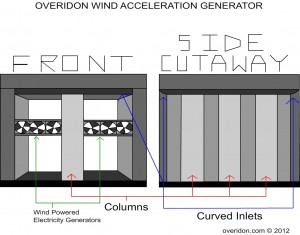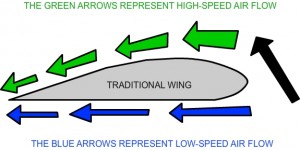
This device uses an inverse of the Bernoulli’s Principle in order to create high-speed air currents which can be harnessed by Wind Electricity Generators
Bernoulli is a well-known scientist who pioneered advancements in the field of thermodynamics among many others. One important piece of knowledge he imparted to us was his insight into the concept of ‘lift’ and how wings can make objects overcome their gravity in an open system.
In the image at the bottom of this technology concept, you will see a rough diagram which shows how air flows over the top of a wing and how it increases in speed. When that happens, the pressure on the top of the wing decreases and the pressure below the wing stays the same. This creates the ‘lift’ which was discussed earlier.
Imagine inverting the system and putting the wing upside-down. The ‘lift’ would happen on the wrong side of the wing, and the object would travel downwards in the open system.
It was this hypothesis/concept which led Overidon Industries back in 2008 to experiment on a small scale in Santa Ana, California with models somehow utilizing this idea. Except instead of using a wing, the inverse Bernoulli concept was put on a fixed structure.
The idea was as such: If the inverse wing was attached to a fixed structure, the air-flow inside the structure would increase in speed. Since velocity takes priority over pressure when it comes to harnessing energy from wind turbines, a permanent structure or system which increases the velocity of air-flow would be a way to amplify the power of wind generator systems.
In 2008, the models were too miniscule in size to show any real change in air flow.
Yesterday, while walking home from the park, it was observed that the air flow underneath a freeway overpass in Pasadena was moving significantly more quickly than the perceived flow of air outside the area of the overpass.
At first glance, this seemed like the wind had changed speed in a short amount of time. But what was really going on, was that the overpass structure itself was affecting the air flow in the area.
This was confirmed by walking back beneath the overpass a second time. It was as if an artificial gust of wind was created out of thin air.
The angular inlets underneath the overpass acted as inefficient yet effective inverse Bernoulli wings which decreased the pressure underneath the overpass and invariably increased the airspeed.
One might be tempted to say that the overpass created a net-zero effect by changing the air-speed and that kinetic energy which can be extracted from the system is actually the same as it would be if no inverse-Bernoulli effect was observed. This would be quite true if the air-flow existed in a closed system. Yet since the system is open to the rest of the surrounding air currents, there is actually no limit to the amount of air which can be harnessed and directed.
To better illustrate this point, an analogy would be appropriate. Think of a biological enzyme within the human bloodstream. These devices are infinitesimally small pieces of technology which perform specific functions upon chemicals and organic compounds within the bloodstream and inside certain cells. These enzymes are more similar to machines than they are to animals. And they function upon their targets not by any means of stored chemical energy or through genetic processes…enzymes do their work through their unique shapes and structures.
It is the shape and configuration of an enzyme which determines how it will affect another entity in the bloodstream.
The large concrete devices that are proposed by this concept are similar to enzymes. But instead of using their structure to affect organic compounds, this technology uses the Bernoulli Principle to interfere with the air flow. This three-dimensional interference pattern is what creates the “noise” which increases the speed of air flow underneath the overpass.
The reason why the term, “noise” is used is because two-dimensional sound is what is created by guitar strings or violins. This sound is potentially harmonic by nature of the vibration. Drums on the other hand, create three-dimensional sound and this type of sound is called, “noise.” Noise cannot harmonize with noise, neither can noise harmonize with two-dimensional sound. Noise patterns have unique character which can only be amplified, enhanced and modified.
By creating a sort of “noise” in the system, the overpass successfully changes the vibrational character of the air-flow. And since there is no limit and more importantly no cost to the amount of air which can flow through the system, directly modifying the air pressure and wind velocity via the structure has enough value to overcome any lack of perceived kinetic energy in the air system.
This takes us to the concept itself and adaptation.
By changing the angular inlets of the freeway overpass to curved shapes, the structure will more-efficiently create the inverse Bernoulli effect upon the airflow. When this change takes place in conjunction with the addition of wind generators placed strategically in the center of the areas of rapid air-flow, the device will be known as an Overidon Wind Acceleration Generator (OWAG).
This generator can be augmented by painting certain sections of the roof of the device black in order to absorb additional heat.
Further augmentations could be attained by combining OWAG units together in concert in order to amplify the desired effect. In reality, it would greatly benefit the OWAG systems if additional “Turbo Charger” systems were built to further recycle rapid-moving exhaust out of the tail of the OWAG.
In the end, an arid tundra or bleached desert in the middle of the United States with only modest air-flow patterns could be transformed into profitable systems for creating lucrative electricity for both domestic use and export. Used strategically in conjunction with coal, natural gas, traditional wind generators, and other energy production techniques…the United States of America could have OWAG units as emergency backup generators in case of an emergency or as “cooling” devices to keep a lid on potentially volatile future energy prices.
Perhaps advancement in architecture, cement mixing and civil engineering could be used together to leave a lasting legacy for our progeny to use during their future generations. As the people of tomorrow comb the surface of our land for glimpses into the minds of their ancestors, they will see structures set in stone…organs, in the sand.
Overidon Wind Acceleration Generator (OWAG)
© 2012 Overidon.com
Tyler Stansfield Jaggers – September 28th, 2012



